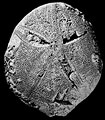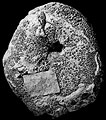|
Diagnostic Features
|
-
Test of medium size, ovate to subpentagonal in outline, oral surface planar, slightly sunken towards the peristome, margins rounded, upper surface planer to low subconical; posterior tapering.
-
Apical system monobasal, anterior, with four genital pores, no sexual dimorphism.
-
Petals well developed, broad, weakly bowed and open distally, with broad interporiferous zones, poriferous zones of equal length in the same petal. Pores conjugate, outer pores elongate, ambulacral plates beyond petals with single pores.
-
Peristome transverse anterior, large, subpentagonal, wider than long. With vertical-walled entrance.
-
Periproct marginal, slightly invaginated beneath and forming a slight notch in some species.
-
Bourrelets weakly developed; fine tuberculation mostly confined to vertical-walled entrance to peristome.
-
Phyllodes broad, single pored, with two or three series of pores in each half-ambulacrum.
-
Buccal pores present.
-
Narrow naked zone in interambulacrum 5 (not always present).
|
|
Distribution
|
-
Upper Cretaceous (Campanian) to ?Miocene of Europe, North Africa, Cuba, Japan, Oman, Tibet, Pakistan, United Arab Emirates and USA.
|
| Name gender |
feminine |
| Type |
Pliolampas tunetana Gauthier, 1889, p. 99; by monotypy.
|
| Species Included |
-
G. ataxensis (Cotteau, 1863); Danian-Thanetian, France, Spain, Oman.
-
G. bulgaricus (Tzankoz, 1934); Maastrichtian, Bulgaria.
-
G. corneti (Cotteau, 1879); Danian-Thanetian, France, Belgium.
-
G. enormis (Duncan & Sladen, 1882); Late Thanetian, Pakistan.
-
G. georgiensis (Twitchell, in Clark & Twitchell, 1915); Early Danian, USA.
-
G. issyaviensis (Munier-Chalmas, 1887); Middle Eocene, France.
-
G. mcnamarae Srivastava et al. 2008; Eocene (lutetian-Bartonian), India
-
G. oblongus (Smiser, 1935); Early Danian, The Netherlands, Belgium.
-
G. tunetana (Gauthier, 1889); Campanian-Thanetian, Tunisia, Tibet.
-
G. tripolitanus (Krumbeck, 1906); Maastrichtian-Danian, Libya, Cuba.
-
G. sendaica Nisiyama, 1968; Middle Miocene, Japan.
-
G. subrotundus (Desor, 1857); Thanetian, Spain.
-
G. zuffardii Checchia-Rispoli, 1921; Maastrichtian, Libya.
-
G. oviformis (Conrad, 1850); Middle Eocene, USA.
-
Gitolampas (Gitolampopsis) lamberti Checchia-Rispoli, 1921; Senonian, Italy.
-
Gitolampas (Gitolampopsis) zuffardii Checchia-Rispoli, 1921; Senonian, Italy.
|
| Classification and/or Status |
Irregularia; Cassiduloida; \'Gitolampadids\'
Clypeanthus Cotteau, 1884 may be a senior subjective synonym of this genus but remains too poorly known for firm synonymy to be made.
|
| Remarks |
Gitolampas differs from Parapygus in having a distinct posterior truncation on which the periproct opens, and a monobasal apical system (tetrabasal in Parapygus).
V. Gauthier. 1889. Description des Echinides fossiles recueillis en 1885 et 1886 dans la region sud des Hautes-Plateaux de la Tunise par M. Philippe Thomas. Exploration scientifique de la Tunise. Imprimerie National, Paris, 116 pp., 32 pls.
P. M. Kier. 1962. Revision of the cassiduloid echinoids. Smithsonian Miscellaneous Collections 144, (3), 262 pp.
A. B. Smith & C. H. Jeffery. 2000. Maastrichtian and Palaeocene echinoids: a key to world faunas. Special Papers in Palaeontology, 63, 406 pp.
|




